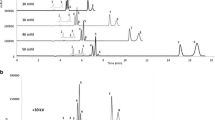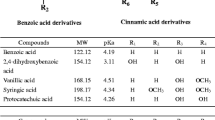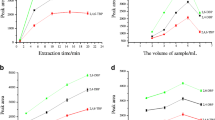Abstract
For environmental analyses, a high-performance and powerful preconcentration system exceeding 1×107-fold was developed that was composed of a blue cotton method (solid extraction method)/homogeneous liquid–liquid extraction method/on-line concentration method for capillary electrophoresis (CE). This system was named the “triplex concentration system” and it was achieved by finding a new phase-separation phenomenon (homogeneous liquid–liquid extraction) from a water-miscible organic solvent. Parts per trillion levels of polycyclic aromatic hydrocarbons (PAHs) were used as model analytical targets in this study. With the proposed method, 20-L levels of environmental water could be preconcentrated up to 1×107-fold within a maximum of 1 h. The parts per trillion levels of PAHs were easily determined even using UV/CE, which has a serious sensitivity problem, and the detection limit of benzo[a]pyrene was 3.60 ppt. This system was also used as a practical monitoring method for the Miyata River (in Japan).







Similar content being viewed by others
References
Takagai Y, Igarashi S (2001) Analyst 129:551
Takagai Y, Igarashi S (2003) Chem Pharm Bull 51:373
Igarashi S, Oshite S (1997) Bunseki 9:702
Takagai Y, Igarashi S (2002) Am Lab 34:29
Igarashi S, Yotsuyanagi T (1992) Mikrochim Acta 106:37
Saitoh T, Tani H, Kamidate T, Watanabe H (1995) Trends Anal Chem 14:213
Bordier C (1981) J Biol Chem 256:1604
Tabata M, Kumamoto M, Nishimoto J (1996) Anal Chem 68:758
Environmental Agency of Japan (1998) Strategic programs on environmental endocrine disruptors ’98 (SPEED ’98). Environmental Agency of Japan, Tokyo
Hayatsu H, Oka T, Wakata A, Ohara Y, Hayatsu T, Kobayashi H, Arimoto S (1983) Mutat Res 119:233
Hayatsu H (1992) J Chromatogr 587:37
Hayatsu H, Hayatsu T, Arimoto S, Sakamoto H (1996) Anal Biochem 235:185–190
Kobayashi S, Harada N, Tokunaga R, Odo J, Hayatsu H (1997) Mutat Res 381:243
Hayatsu H (1990) Advances in mutagenesis research, vol 1. Springer, Berlin Heidelberg New York, pp 1–26
Hayatsu H (2000) Yakugaku Zasshi 120:534
Quirino JP, Terabe S (1998) Science 282:465
Quirino JP, Terabe S (1997) J Chromatogr A 781:119
Quirino JP, Kim JB, Terabe S (2002) J Chromatogr A 965:357
Othuka K, Higashimori M, Koike R, Karuhaka K, Okada Y, Terabe S (1994) Electorophoresis 15:1280
Environmental Agency of Japan (1998) Manual of analytical method for the endocrine disrupting chemicals. Environmental Agency of Japan, Tokyo
Author information
Authors and Affiliations
Corresponding author
Rights and permissions
About this article
Cite this article
Takagai, Y., Akiyama, R. & Igarashi, S. Powerful preconcentration method for capillary electrophoresis and its application to analysis of ultratrace amounts of polycyclic aromatic hydrocarbons. Anal Bioanal Chem 385, 888–894 (2006). https://doi.org/10.1007/s00216-006-0447-9
Received:
Revised:
Accepted:
Published:
Issue Date:
DOI: https://doi.org/10.1007/s00216-006-0447-9




